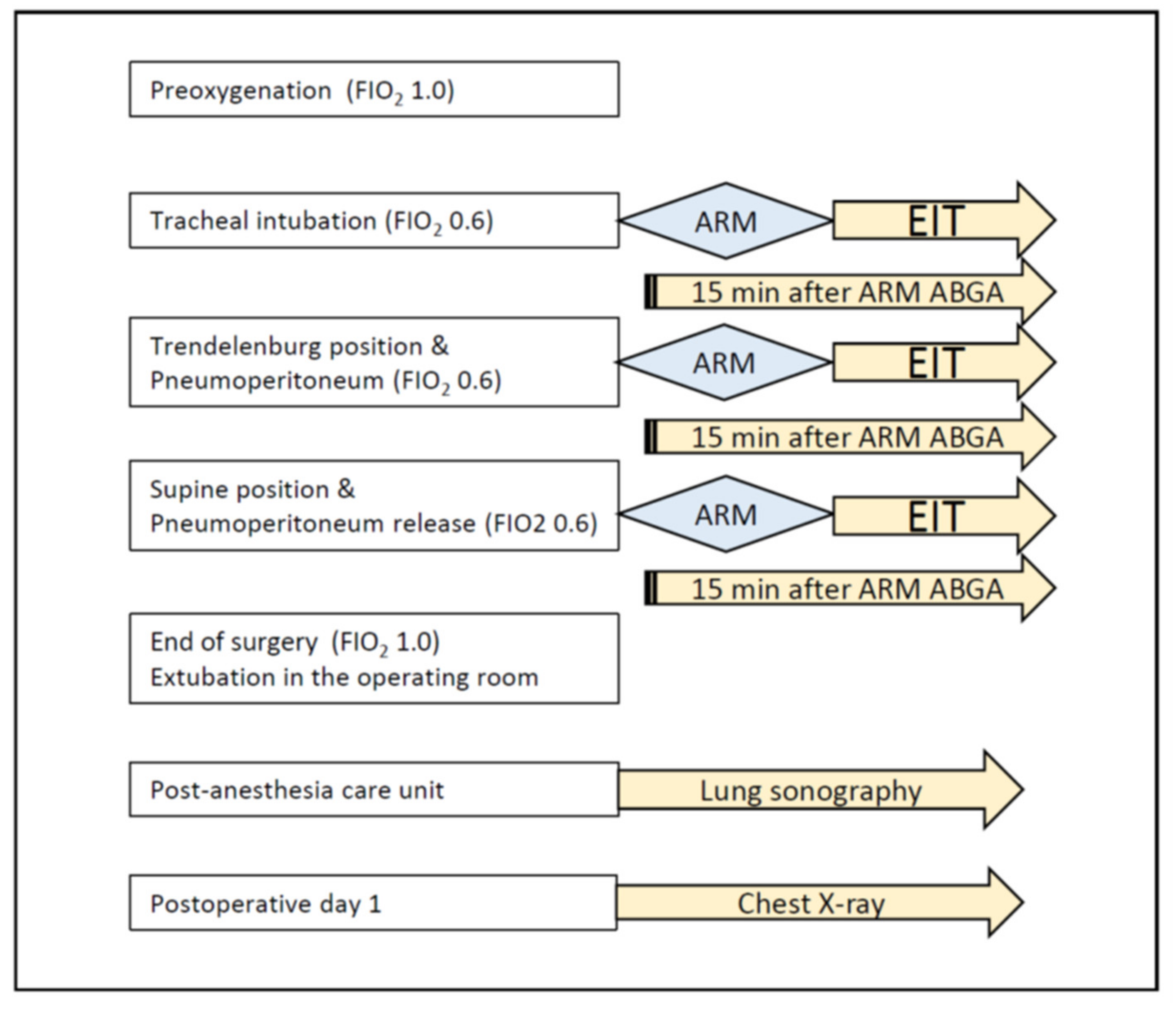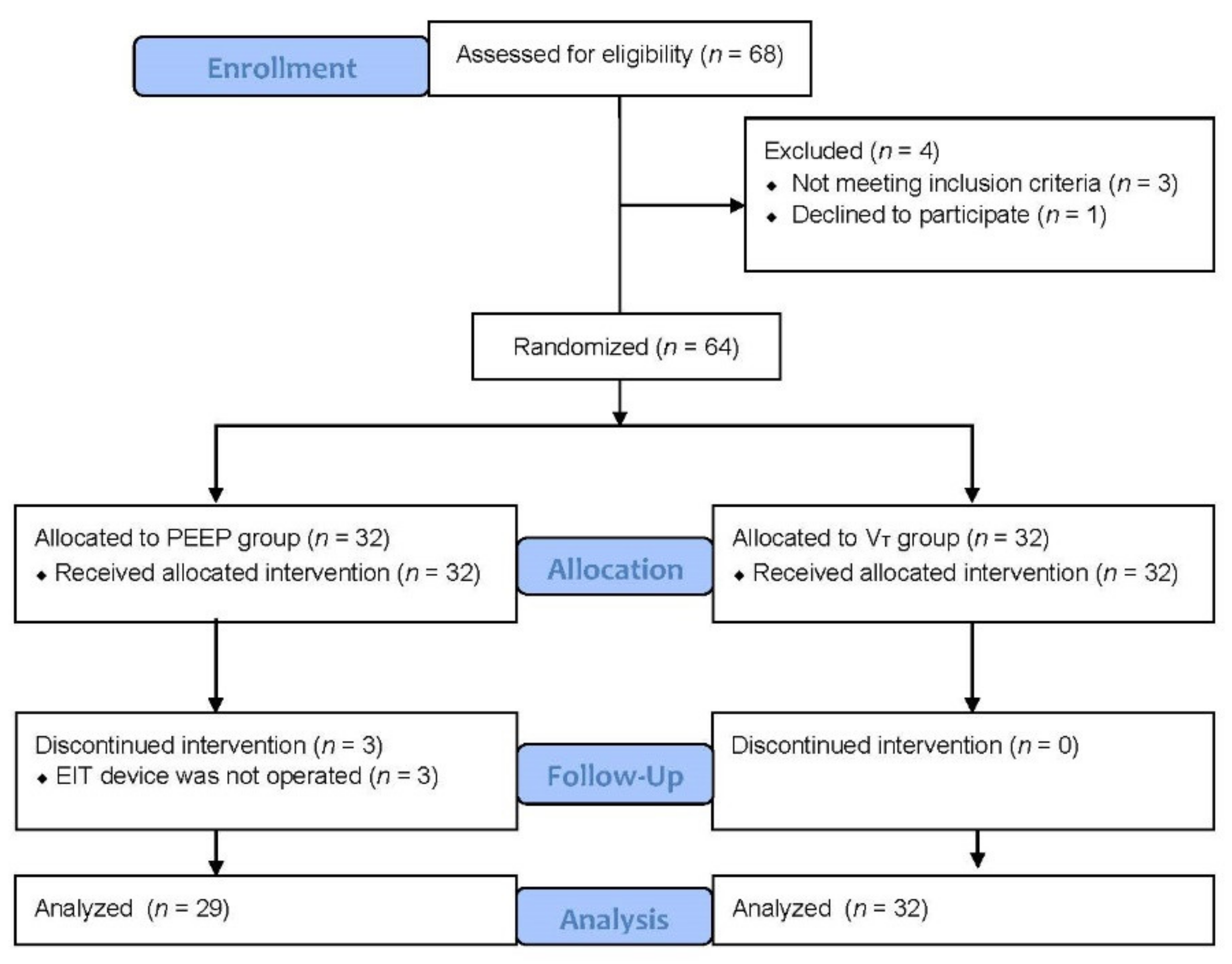Comparison of Positive End-Expiratory Pressure versus Tidal Volume-Induced Ventilator-Driven Alveolar Recruitment Maneuver in Robotic Prostatectomy: A Randomized Controlled Study
Abstract
:1. Introduction
2. Materials and Methods
2.1. Patients and Study Design
2.2. Anesthesia and Surgery
2.3. Study Protocol for Each Recruitment Maneuver
2.3.1. The PEEP Group
2.3.2. The VT Group
2.4. Measurements
2.5. Statistical Analysis
3. Results
3.1. Effect of the PEEP Group vs. the VT Group on Restoring EELI
3.2. Effect of PEEP Group vs. VT Group on Lung Compliance and Oxygenation
3.3. Postoperative Outcomes
4. Discussion
Author Contributions
Funding
Institutional Review Board Statement
Informed Consent Statement
Data Availability Statement
Conflicts of Interest
References
- Gunnarsson, L.; Tokics, L.; Gustavsson, H.; Hedenstierna, G. Influence of age on atelectasis formation and gas exchange impairment during general anaesthesia. Br. J. Anaesth. 1991, 66, 423–432. [Google Scholar] [CrossRef]
- Pelosi, P.; Foti, G.; Cereda, M.; Vicardi, P.; Gattinoni, L. Effects of carbon dioxide insufflation for laparoscopic cholecystectomy on the respiratory system. Anaesthesia 1996, 51, 744–749. [Google Scholar] [CrossRef] [PubMed]
- Kalmar, A.F.; Foubert, L.; Hendrickx, J.F.; Mottrie, A.; Absalom, A.; Mortier, E.P.; Struys, M.M. Influence of steep Trendelenburg position and CO(2) pneumoperitoneum on cardiovascular, cerebrovascular, and respiratory homeostasis during robotic prostatectomy. Br. J. Anaesth. 2010, 104, 433–439. [Google Scholar] [CrossRef] [Green Version]
- Schrijvers, D.; Mottrie, A.; Traen, K.; De Wolf, A.M.; Vandermeersch, E.; Kalmar, A.F.; Hendrickx, J.F. Pulmonary gas exchange is well preserved during robot assisted surgery in steep Trendelenburg position. Acta Anaesthesiol. Belg. 2009, 60, 229–233. [Google Scholar] [PubMed]
- Ukere, A.; März, A.; Wodack, K.H.; Trepte, C.J.; Haese, A.; Waldmann, A.D.; Böhm, S.H.; Reuter, D.A. Perioperative assessment of regional ventilation during changing body positions and ventilation conditions by electrical impedance tomography. Br. J. Anaesth. 2016, 117, 228–235. [Google Scholar] [CrossRef] [PubMed] [Green Version]
- Hess, D.R.; Bigatello, L.M. Lung recruitment: The role of recruitment maneuvers. Respir. Care 2002, 47, 308–317. [Google Scholar] [PubMed]
- Anderson, A.; Alexanders, J.; Sinani, C.; Hayes, S.; Fogarty, M. Effects of ventilator vs manual hyperinflation in adults receiving mechanical ventilation: A systematic review of randomised clinical trials. Physiotherapy 2015, 101, 103–110. [Google Scholar] [CrossRef] [PubMed]
- Hartland, B.L.; Newell, T.J.; Damico, N. Alveolar recruitment maneuvers under general anesthesia: A systematic review of the literature. Respir. Care 2015, 60, 609–620. [Google Scholar] [CrossRef] [Green Version]
- Godet, T.; Constantin, J.M.; Jaber, S.; Futier, E. How to monitor a recruitment maneuver at the bedside. Curr. Opin. Crit. Care 2015, 21, 253–258. [Google Scholar] [CrossRef]
- Kobylianskii, J.; Murray, A.; Brace, D.; Goligher, E.; Fan, E. Electrical impedance tomography in adult patients undergoing mechanical ventilation: A systematic review. J. Crit. Care 2016, 35, 33–50. [Google Scholar] [CrossRef]
- Frerichs, I.; Hinz, J.; Herrmann, P.; Weisser, G.; Hahn, G.; Dudykevych, T.; Quintel, M.; Hellige, G. Detection of local lung air content by electrical impedance tomography compared with electron beam CT. J. Appl. Physiol. 2002, 93, 660–666. [Google Scholar] [CrossRef]
- Hinz, J.; Hahn, G.; Neumann, P.; Sydow, M.; Mohrenweiser, P.; Hellige, G.; Burchardi, H. End-expiratory lung impedance change enables bedside monitoring of end-expiratory lung volume change. Intensiv. Care Med. 2003, 29, 37–43. [Google Scholar] [CrossRef]
- Van Genderingen, H.R.; van Vught, A.J.; Jansen, J.R. Estimation of regional lung volume changes by electrical impedance pressures tomography during a pressure-volume maneuver. Intensiv. Care Med. 2003, 29, 233–240. [Google Scholar] [CrossRef] [PubMed]
- Linnane, M.P.; Caruana, L.R.; Tronstad, O.; Corley, A.; Spooner, A.J.; Barnett, A.G.; Thomas, P.J.; Walsh, J.R. A comparison of the effects of manual hyperinflation and ventilator hyperinflation on restoring end-expiratory lung volume after endotracheal suctioning: A pilot physiologic study. J. Crit. Care 2019, 49, 77–83. [Google Scholar] [CrossRef] [PubMed] [Green Version]
- Grant, C.A.; Fraser, J.F.; Dunster, K.R.; Schibler, A. The assessment of regional lung mechanics with electrical impedance tomography: A pilot study during recruitment manoeuvres. Intensiv. Care Med. 2009, 35, 166–170. [Google Scholar] [CrossRef]
- Karsten, J.; Stueber, T.; Voigt, N.; Teschner, E.; Heinze, H. Influence of different electrode belt positions on electrical impedance tomography imaging of regional ventilation: A prospective observational study. Crit. Care 2016, 20, 3. [Google Scholar] [CrossRef] [PubMed] [Green Version]
- Monastesse, A.; Girard, F.; Massicotte, N.; Chartrand-Lefebvre, C.; Girard, M. Lung ultrasonography for the assessment of perioperative atelectasis: A pilot feasibility study. Anesth. Analg. 2017, 124, 494–504. [Google Scholar] [CrossRef]
- Tusman, G.; Böhm, S.H.; de Anda, G.F.V.; do Campo, J.L.; Lachmann, B. ‘Alveolar recruitment strategy’ improves arterial oxygenation during general anaesthesia. Br. J. Anaesth. 1999, 82, 8–13. [Google Scholar] [CrossRef]
- Hedenstierna, G.; Rothen, H.U. Atelectasis formation during anesthesia: Causes and measures to prevent it. J. Clin. Monit. Comput. 2000, 16, 329–335. [Google Scholar] [CrossRef]
- Lumb, A.B.; Greenhill, S.J.; Simpson, M.P.; Stewart, J. Lung recruitment and positive airway pressure before extubation does not improve oxygenation in the post-anaesthesia care unit: A randomized clinical trial. Br. J. Anaesth. 2010, 104, 643–647. [Google Scholar] [CrossRef] [Green Version]
- Cakmakkaya, O.S.; Kaya, G.; Altintas, F.; Hayirlioglu, M.; Ekici, B. Restoration of pulmonary compliance after laparoscopic surgery using a simple alveolar recruitment maneuver. J. Clin. Anesth. 2009, 21, 422–426. [Google Scholar] [CrossRef]
- Savian, C.; Paratz, J.; Davies, A. Comparison of the effectiveness of manual and ventilator hyperinflation at different levels of positive end-expiratory pressure in artificially ventilated and intubated intensive care patients. Heart Lung 2006, 35, 334–341. [Google Scholar] [CrossRef] [PubMed]
- Lim, C.-M.; Lee, S.S.; Lee, J.S.; Koh, Y.; Shim, T.S.; Do Lee, S.; Kim, W.S.; Kim, D.-S.; Kim, W.D. Morphometric effects of the recruitment maneuver on saline-lavaged canine lungs. A computed tomographic analysis. Anesthesiology 2003, 99, 71–80. [Google Scholar] [CrossRef] [PubMed]
- Luecke, T.; Roth, H.; Herrmann, P.; Joachim, A.; Weisser, G.; Pelosi, P.; Quintel, M. PEEP decreases atelectasis and extravascular lung water but not lung tissue volume in surfactant-washout lung injury. Intensiv. Care Med. 2003, 29, 2026–2033. [Google Scholar] [CrossRef]
- Rothen, H.U.; Sporre, B.; Engberg, G.; Wegenius, G.; Högman, M.; Hedenstierna, G. Influence of gas composition on recurrence of atelectasis after a reexpansion maneuver during general anesthesia. Anesthesiology 1995, 82, 832–842. [Google Scholar] [CrossRef]
- Nieszkowska, A.; Lu, Q.; Vieira, S.; Elman, M.; Fetita, C.; Rouby, J.J. Incidence and regional distribution of lung overinflation during mechanical ventilation with positive end-expiratory pressure. Crit. Care Med. 2004, 32, 1496–1503. [Google Scholar] [CrossRef]
- Bordes, J.; Mazzeo, C.; Gourtobe, P.; Cungi, P.J.; Antonini, F.; Bourgoin, S.; Kaiser, E. Impact of extraperitoneal dioxyde carbon insufflation on respiratory function in anesthetized adults: A preliminary study using electrical impedance tomography and wash-out/wash-in technic. Anesthesiol. Pain Med. 2015, 5, e22845. [Google Scholar] [CrossRef] [PubMed] [Green Version]



| PEEP Group (n = 29) | VT Group (n = 32) | p Value | |
|---|---|---|---|
| Age, yr (range) | 67 (56, 75) | 65 (54, 75) | 0.244 |
| Body mass index, kg m−2 | 24.4 (2.5) | 25.0 (2.3) | 0.323 |
| Height, cm | 167 (6) | 168 (6) | 0.813 |
| Weight, kg | 68 (9) | 70 (9) | 0.360 |
| ASA I/II | 2/27 | 4/48 | 0.674 |
| Left ventricle ejection fraction, % | 65 (4) | 65 (5) | 0.771 |
| Comorbid conditions | |||
| Hypertension | 13 (45%) | 14 (44%) | 0.933 |
| Diabetics mellitus | 9 (31%) | 3 (9%) | 0.034 |
| Angina | 2 (7%) | 0 (0%) | 0.214 |
| Current smoking | 4 (14%) | 2 (6%) | 0.411 |
| Pulmonary function test | 0.401 | ||
| Normal | 19 (66%) | 23 (72%) | |
| Mild obstructive pattern | 6 (21%) | 4 (13%) | |
| Duration of anesthesia, min | 214 (46) | 213 (49) | 0.910 |
| Duration of surgery, min | 178 (45) | 173 (47) | 0.705 |
| Duration of capnoperitoneum, min | 152 (53) | 152 (47) | 0.991 |
| Before Alveolar Recruitment Maneuver | After Alveolar Recruitment Maneuver | |||||
|---|---|---|---|---|---|---|
| PEEP Group | VT Group | p Value | PEEP Group | VT Group | p Value | |
| T1 | ||||||
| ROI (1 and 2), % | 57 [48,66] | 58 [53,62] | 0.729 | 56 [48,67] | 59 [52,62] | 0.939 |
| ROI (3 and 4), % | 37 [28,42] | 36 [31,42] | 0.892 | 38 [27,45] | 37 [32,42] | 0.746 |
| PIP | 15.5 (1.5) | 15.4 (1.6) | 0.858 | 14.4 (1.5) | 14.5 (1.5) | 0.824 |
| DP, cmH2O | 7 [6,8] | 7 [6,8] | 0.829 | 5 [5,7] | 6 [6,7] | 0.043 |
| Crs, mL cmH2O−1 | 65.8 (12.9) | 64.6 (11.1) | 0.694 | 81.7 (14.1) | 72.9 (12.0) | 0.011 |
| PaO2/FIO2, mmHg | 432.4 (92.9) | 395.2 (140.8) | 0.245 | |||
| T2 | ||||||
| ROI (1 and 2), % | 57 [48,66] | 58 [53,62] | 0.405 | 56 [48,67] | 59 [52,62] | 0.405 |
| ROI (3 and 4), % | 37 [28,42] | 36 [31,42] | 0.789 | 38 [27,45] | 37 [32,42] | 0.451 |
| PIP | 26.8 (2.6) | 26.9 (3.2) | 0.845 | 25.2 (2.7) | 25.6 (3.2) | 0.660 |
| DP, cmH2O | 19 [17,22] | 18 [17,21] | 0.597 | 18 [16,20] | 17 [16,19] | 0.372 |
| Crs, mL cmH2O−1 | 23.4 (3.3) | 24.3 (3.9) | 0.322 | 26.1 (3.9) | 26.3 (5.3) | 0.842 |
| PaO2/FIO2, mmHg | 377.2 (126.1) | 409.4 (93.2) | 0.266 | |||
| T3 | ||||||
| ROI (1 and 2) | 57 [47,61] | 56 [49,65] | 0.533 | 56 [45,62] | 60 [51,69] | 0.183 |
| ROI (3 and 4) | 39 [33,45] | 38 [29,46] | 0.076 | 42 [33,50] | 35 [20,39] | 0.462 |
| PIP | 16.7 (1.4) | 16.8 (1.9) | 0.845 | 15.2 (1.3) | 15.5 (1.6) | 0.660 |
| DP, cmH2O | 9 [8,9] | 9 [7,10] | 0.768 | 6 [5,7] | 6 [6,8] | 0.047 |
| Crs, mL cmH2O−1 | 55.1 (10.6) | 55.9 (9.6) | 0.772 | 77.7 (13.3) | 70.3 (12.1) | 0.000 |
| PaO2/FIO2, mmHg | 417.0 (102.5) | 421.3 (81.4) | 0.857 | |||
Publisher’s Note: MDPI stays neutral with regard to jurisdictional claims in published maps and institutional affiliations. |
© 2021 by the authors. Licensee MDPI, Basel, Switzerland. This article is an open access article distributed under the terms and conditions of the Creative Commons Attribution (CC BY) license (https://creativecommons.org/licenses/by/4.0/).
Share and Cite
Jung, K.; Kim, S.; Kim, B.J.; Park, M. Comparison of Positive End-Expiratory Pressure versus Tidal Volume-Induced Ventilator-Driven Alveolar Recruitment Maneuver in Robotic Prostatectomy: A Randomized Controlled Study. J. Clin. Med. 2021, 10, 3921. https://doi.org/10.3390/jcm10173921
Jung K, Kim S, Kim BJ, Park M. Comparison of Positive End-Expiratory Pressure versus Tidal Volume-Induced Ventilator-Driven Alveolar Recruitment Maneuver in Robotic Prostatectomy: A Randomized Controlled Study. Journal of Clinical Medicine. 2021; 10(17):3921. https://doi.org/10.3390/jcm10173921
Chicago/Turabian StyleJung, Kangha, Sojin Kim, Byung Jun Kim, and MiHye Park. 2021. "Comparison of Positive End-Expiratory Pressure versus Tidal Volume-Induced Ventilator-Driven Alveolar Recruitment Maneuver in Robotic Prostatectomy: A Randomized Controlled Study" Journal of Clinical Medicine 10, no. 17: 3921. https://doi.org/10.3390/jcm10173921
APA StyleJung, K., Kim, S., Kim, B. J., & Park, M. (2021). Comparison of Positive End-Expiratory Pressure versus Tidal Volume-Induced Ventilator-Driven Alveolar Recruitment Maneuver in Robotic Prostatectomy: A Randomized Controlled Study. Journal of Clinical Medicine, 10(17), 3921. https://doi.org/10.3390/jcm10173921






